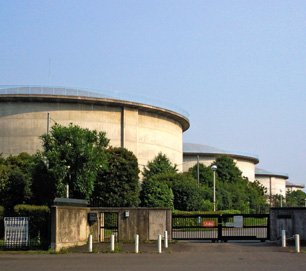Chlorite, Chlorate and Chlorine Dioxide
| EPA Maximum Residual Disinfectant Level (MRDL) |
Chlorine Dioxide | 0.8 mg/L |
| EPA Maximum Contaminant Level (MCL) |
Chlorite | 1.0 mg/L |

A water purification plant in Tokorozawa, Japan. Chlorite and chlorate are disinfection byproducts that may form during water treatment involving chlorine dioxide.
Chlorite and chlorate are disinfection byproducts that can form as a result of water disinfection involving chlorine dioxide.
Chlorine dioxide is used in some municipal water treatments as an alternative to chlorine for microbe removal and taste/odor improvement, or as a pre-treatment in chlorinated waters to remove precursors to trihalomethanes. It's also used industrially as a bleaching agent for paper, flour and oils, and in leather preparation. When used to treat water, it decomposes quickly into chlorate, chloride, and most commonly, chlorite.
Health Effects of Chlorite, Chlorate and Chlorine Dioxide
Exposure to chlorine dioxide and chlorite in excess of EPA-regulated maximum levels can have effects on the nervous system in infants, small children, and unborn fetuses. Chlorite and chlorate have been shown to effect red blood cells in animal studies, but similar results did not appear in the highest doses tested on humans (36 micrograms per kilogram of body weight).
According to the EPA, long term exposure to large amounts may lead to anemia. There is currently no evidence of human carcinogenicity.
Water Treatment for Chlorite, Chlorate and Chlorine Dioxide
According to the Canadian Committee on Drinking Water, “some residential-scale treatment devices using a granular activated carbon filter may remove chlorite,” although they have not yet certified any filters for that use. There is no recommended treatment for chlorate.
Sources: EPA (1), EPA (2), WHO, Wikipedia, Canadian Federal-Provincial-Territorial Committee on Drinking Water
Site Index
Filtration Systems
- Aeration for Iron & Sulfide
- Backwashing Filters
(whole house & well units)
- Chlorine & Chemical Injectors
- Countertop Water Filters
- Garden Hose Filters
- Reverse Osmosis, Residential
- Reverse Osmosis, Commercial
- Shower Filters
- Specialty Filters
- Ultraviolet Systems
- Undersink Filters
- Water Softeners
- Whole House Filters
Cartridges
Parts
- Replacement Parts
- Faucets
- Filter Media
- Fittings
- Housings
- O-rings
- Pumps
- Pura UV
- R.O. Parts
- R.O. Tanks
- R.O. Booster Pump
- VIQUA UV